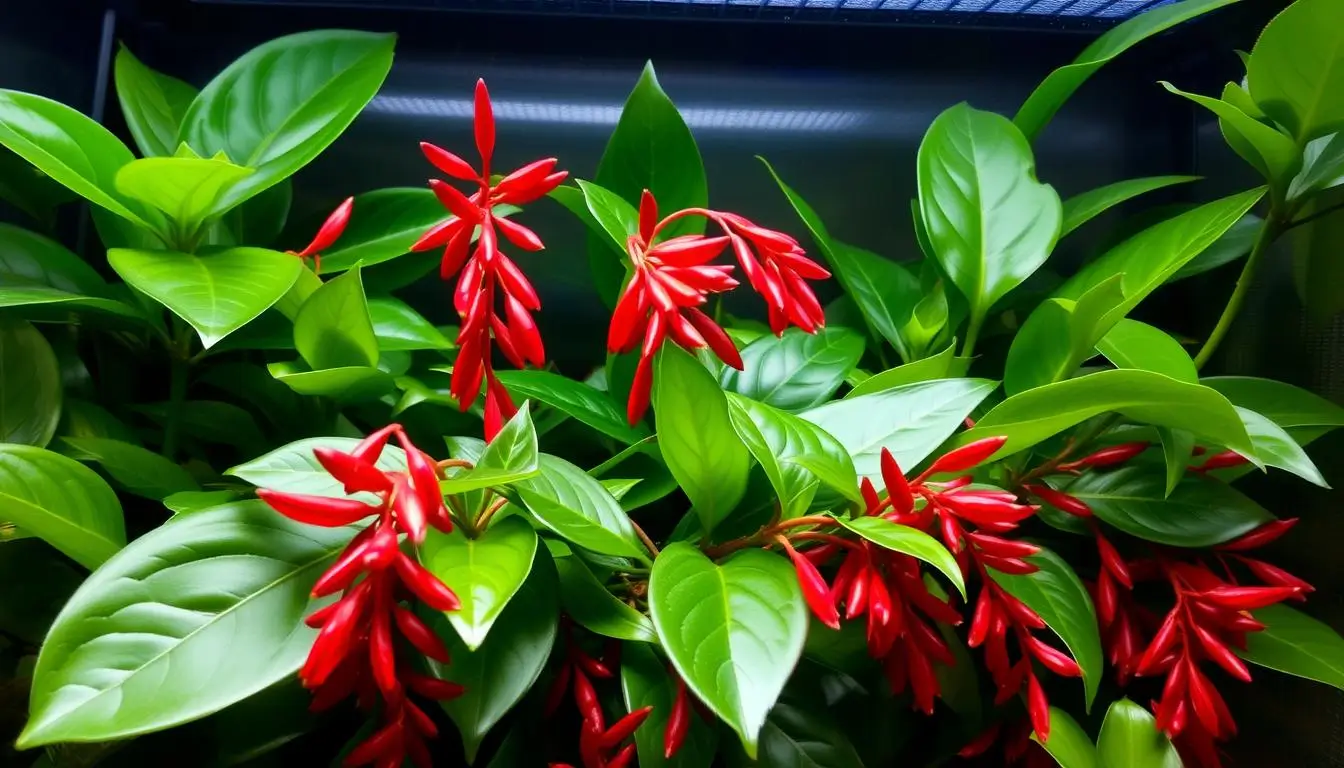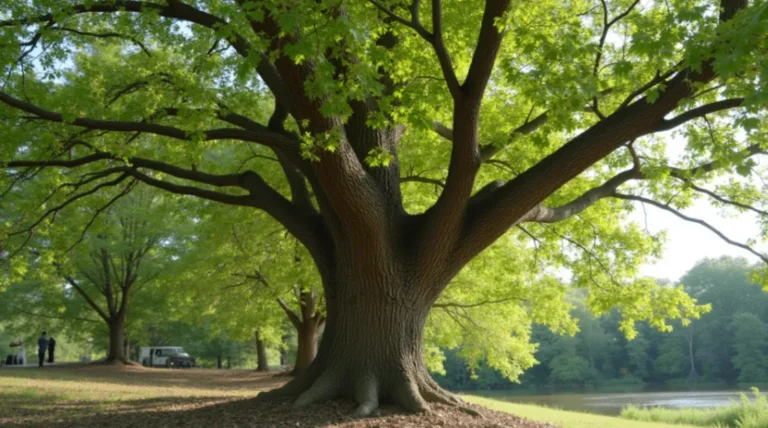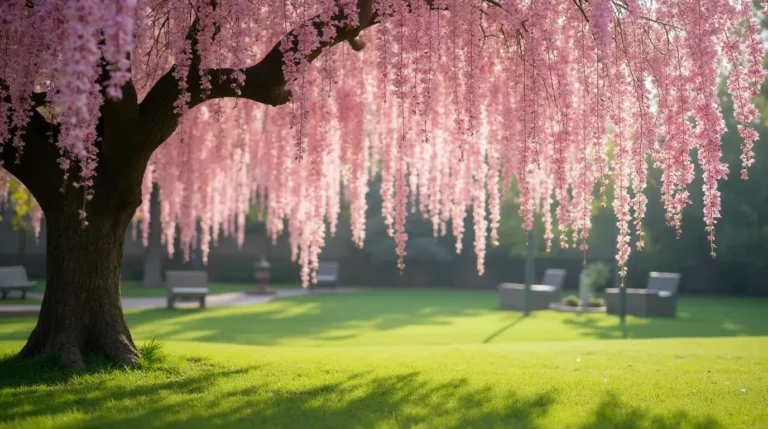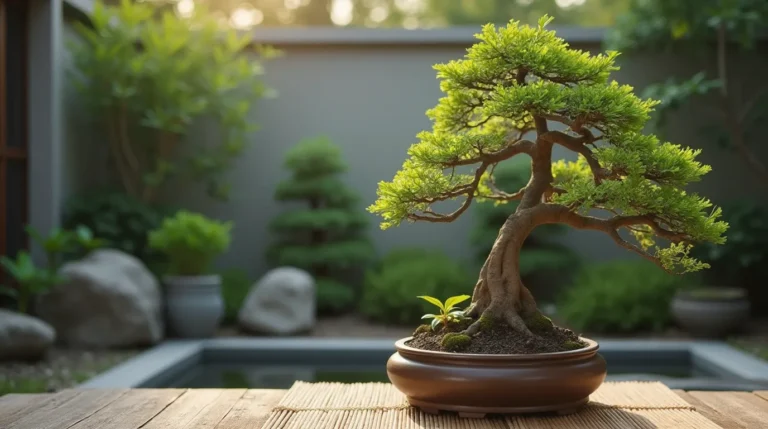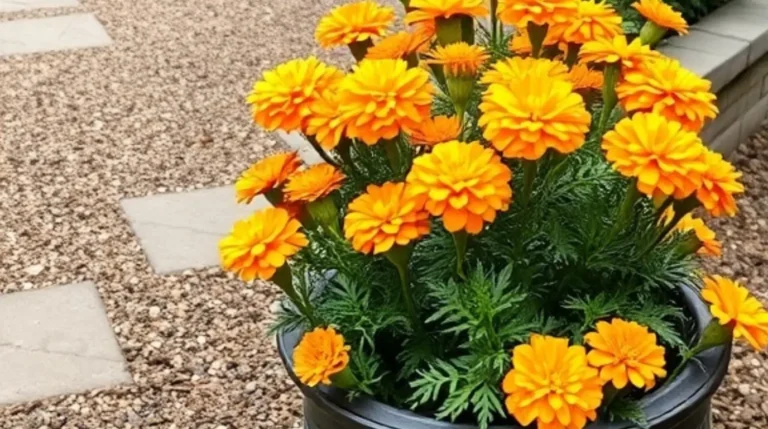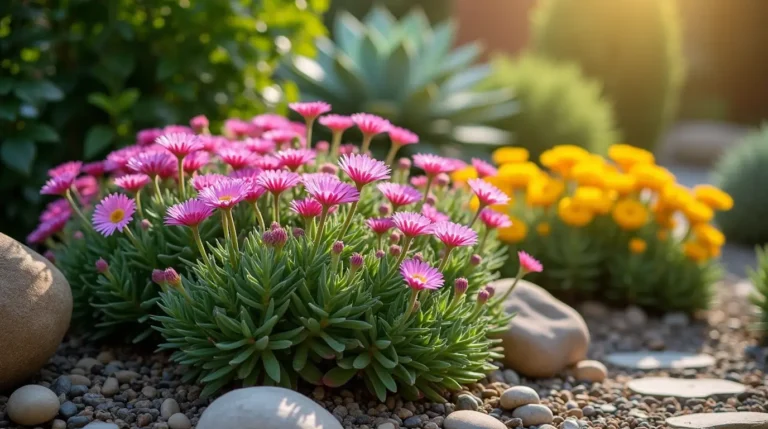Lipstick Plant (Aeschynanthus) Problems And How To Fix Them
The Aeschynanthus radicans, commonly known as the lipstick plant, is a striking evergreen perennial often grown as a houseplant. The plant is named for its bright red, tube-shaped blooms that look like a stick of lipstick.

To thrive, this plant requires a well-draining potting mix and specific conditions, including warmth, humidity, and filtered sunlight. Despite its exotic appearance, the lipstick plant can develop various problems if its care needs aren’t met, affecting its health and blooming capacity.
Understanding common issues is essential for maintaining the plant’s vibrant leaves and encouraging its unique flowering pattern. This guide will help identify the causes of struggles in your lipstick plant and provide practical solutions to restore its health.
Key Takeaways
- Identify common problems affecting lipstick plants.
- Understand the importance of proper care and conditions.
- Learn practical solutions to restore plant health.
- Discover how to encourage blooming and vibrant leaves.
- Explore remedies for environmental and pest-related issues.
Understanding Your Lipstick Plant
To keep your lipstick plant thriving, it’s essential to understand its unique characteristics and needs. Lipstick plants are tropical flowering houseplants known for their vibrant, tube-shaped flowers.
What Makes Lipstick Plants Special
Lipstick plants are considered easy to care for, making them a great choice for indoor gardening. They are epiphytes, naturally growing on other plants or surfaces without being parasitic. This characteristic influences their soil and watering requirements.
Popular Lipstick Plant Varieties
There are several varieties of lipstick plants, each with its unique features. While the most common variety is known for its bright red flowers, other varieties may have different flower colors or leaf patterns.
Basic Care Requirements
To keep a lipstick plant healthy, place it in a spot with bright but indirect sunlight. Use a well-draining potting mix that includes perlite and organic matter. Maintain consistent moisture during the growing season, but avoid overwatering. Ensure higher-than-average humidity levels and stable temperatures between 65-75°F (18-24°C).

Common Lipstick Plant Problems
Despite being relatively low-maintenance, lipstick plants can encounter several common problems that affect their health and appearance. Knowing these problems is essential to help your plant grow well.
Leaf Yellowing and Dropping
One of the common issues with lipstick plants is the yellowing and dropping of leaves. This can be due to overwatering, which causes the roots to rot, or underwatering, which stresses the plant. Ensuring the right balance of moisture in the soil is key.
Wilting and Drooping Issues
Wilting and drooping can be a signs of inadequate watering or low humidity around the plant. Lipstick plants prefer a humid environment, typically between 40% and 60% relative humidity. Adjusting the watering schedule and using a humidifier can help alleviate these symptoms.
Lack of Blooms
A lack of blooms on a lipstick plant can be disappointing. This issue is often related to insufficient light, as these plants require bright, indirect light to bloom well. Adjusting the plant’s position to receive more appropriate light can encourage flowering.
Pest Infestations
Lipstick plants can occasionally suffer from pests like spider mites, mealybugs, and aphids. Regular inspection and maintaining good hygiene around the plant can help prevent infestations. Using horticultural oils or washing the pests off with a water spray are effective treatments.
| Common Pests | Symptoms | Treatment |
|---|---|---|
| Spider Mites | Tiny moving dots, fine webbing on leaves | Horticultural oils, water spray |
| Mealybugs | White, cotton-like clusters on leaf axils and stem joints | Horticultural oils, water spray |
| Aphids | Clusters on new growth and flower buds, causing distortion | Horticultural oils, water spray |
Using a well-draining potting mix can also help prevent root rot and other problems associated with waterlogged soil. Regular monitoring and appropriate care adjustments can keep your lipstick plant healthy and thriving.

How to Fix Lipstick Plant Problems
Understanding the causes of lipstick plant problems is crucial to finding effective solutions. By identifying the root cause, you can take the right steps to fix the issue and get your plant back to its healthy state.
Adjusting Light Conditions
Lipstick plants require bright, indirect light to bloom. Without adequate light, your plant might fail to bloom. To fix this, move the plant to a brighter location or consider using grow lights.

Correcting Watering Issues
Overwatering is a common issue with lipstick plants, leading to root rot and other problems. To correct this, check the soil moisture by sticking your finger into the soil up to the first knuckle. If the soil feels dry, it’s time to water.
Adjust your watering schedule according to the season. During the growing season (spring and summer), lipstick plants need more water, while during the dormant season (fall and winter), they require less.
Improving Soil and Drainage
Lipstick plants prefer well-draining soil to prevent root rot. To improve soil drainage, mix in some perlite or sand. This will help excess water drain through, reducing the risk of waterlogged soil.
Repot your lipstick plant every 2 to 3 years to refresh the soil and accommodate growth.
Managing Temperature and Humidity
Lipstick plants thrive in temperatures between 65°F and 75°F (18°C and 24°C). Avoid placing your plant near heating or cooling vents, fireplaces, or drafty windows.
Maintain humidity by placing the plant on a pebble tray with water or using a nearby humidifier.
Treating Pests and Diseases
Lipstick plants can occasionally get pests like aphids, mites, or mealybugs. To treat these issues, use neem oil or insecticidal soap. For fungal diseases, remove affected leaves, improve air circulation, and treat with a copper-based fungicide if necessary.
- For spider mite infestations, increase humidity and treat with insecticidal soap or neem oil, applying to all plant surfaces every 7-10 days until resolved.
- Combat mealybugs by removing visible insects with an alcohol-dipped cotton swab before applying insecticidal soap to the entire plant.
- For fungal issues, immediately remove affected leaves and improve air circulation around the plant.
Preventative Care for Healthy Lipstick Plants
Maintaining a healthy lipstick plant involves several preventative measures. Regular pruning of stems encourages new growth and maintains an attractive appearance. It’s recommended to remove up to 1/3 of each vine using clean scissors or shears.

Fertilization is also crucial during the growing season. Feed with a balanced, water-soluble fertilizer diluted to half strength every 2 to 3 weeks during spring and summer. Providing a winter rest period with cooler temperatures and reduced watering helps set flower buds for spring blooming.
Rotating hanging baskets quarterly ensures even growth, and inspecting new growth regularly for pests or diseases is also important. By following these preventative care tips, you can enjoy a thriving lipstick plant with vibrant blooms.
FAQ
What is the ideal temperature for Aeschynanthus radicans?
Aeschynanthus radicans prefers temperatures between 65°F and 75°F (18°C and 24°C). Avoid placing it near drafty windows or air conditioning vents to maintain a stable temperature.
How often should I fertilize my lipstick plant during the growing season?
Feed your lipstick plant with a balanced, water-soluble fertilizer during the spring and summer months. Always dilute the fertilizer to half strength to prevent root burn.
Why are the buds on my lipstick plant dropping off?
Bud drop can be caused by sudden changes in temperature, humidity, or light exposure. Ensure your Lipstick Plant is receiving consistent conditions, and avoid moving it to a different location.
Can I grow Aeschynanthus radicans in direct sunlight?
While Aeschynanthus radicans can tolerate some direct sunlight, it’s best to provide bright, indirect light to prevent scorching of the leaves. East- or west-facing windows are ideal for this species.
How do I propagate a new lipstick plant?
Take 4- to 6-inch stem cuttings with at least two nodes, remove lower leaves, and plant them in a well-draining potting mix. Keep the soil consistently warm and moist while the roots are developing.
What is the best potting mix for Aeschynanthus radicans?
Use a potting mix specifically designed for tropical plants, with good drainage and aeration. A mix containing peat moss, perlite, or vermiculite will help retain moisture while preventing root rot.

